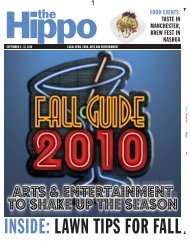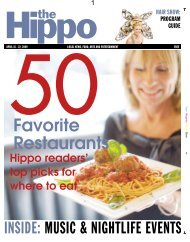Or Download this issue (~35mb) as a PDF - Hippo
Or Download this issue (~35mb) as a PDF - Hippo
Or Download this issue (~35mb) as a PDF - Hippo
Create successful ePaper yourself
Turn your PDF publications into a flip-book with our unique Google optimized e-Paper software.
42<br />
Cyan Magenta Yellow Black<br />
Have You Tried The Best Ice Cream?<br />
HOT DOG SPECIAL!<br />
2 Hot Dogs, Chips & Med. Soda<br />
$ 3 .85<br />
+TAX<br />
LET US DO<br />
THE COOKING!<br />
We Are Your Local Butcher…<br />
Freezer Fre Packages From<br />
PACKAGE #1:<br />
<strong>Hippo</strong> | July 1 - 7, 2010 | Page 42<br />
T H I S W E E K’S S P E C I A L S<br />
We now o er HOME-MADE<br />
Ready-To-Eat Entrees! Take a break,<br />
we’ve got dinner covered!<br />
We Are Your Local Butcher...Freezer Packages from $26.45<br />
fill your ffreezer<br />
with savings<br />
ill your ur freezer wwith<br />
savings<br />
Sale effective 6/28/10 - 7/4/10<br />
710 Somerville Street<br />
Manchester, NH<br />
(603) 668-0444<br />
Package<br />
Price $ 6049 27 lbs. for ONLY<br />
ur freezer 27 6.99 Lbs. for ONLY<br />
eezer er 27 with Lbs. savings<br />
for ONLY<br />
s. for ONLY<br />
$ 1 off<br />
a small or<br />
large cone<br />
Hayward’s Ice Cream<br />
Expires 7/31/10<br />
Can not be combined<br />
with any other offer<br />
Ask for MEAT PACKAGE #5<br />
$ 1 off<br />
a sundae or<br />
banana boat<br />
Hayward’s Ice Cream<br />
Expires 7/31/10<br />
Can not be combined<br />
with any other offer<br />
Ice Cream • Yogurt • Lunches<br />
www.haywardsicecream.com<br />
7 D.W. Hwy, So. N<strong>as</strong>hua: 11am–10pm<br />
383 Elm St., Milford: 11am–9pm<br />
063325<br />
STORE HOURS<br />
Mon–Sat 8am–8pm<br />
Sun 9am–7pm<br />
061910<br />
42<br />
063382<br />
Making a c<strong>as</strong>e for pink<br />
Why rosés are perfect for summer<br />
By Paulette Eschrich<br />
food@hippopress.com<br />
Summer is officially in full swing with<br />
the 4th of July weekend on the horizon and<br />
I am compelled to come to the defense of<br />
the much-maligned wine that falls between<br />
white and red, a wine that is particularly<br />
refreshing and versatile for summer — and<br />
year-round — sipping.<br />
Traditional rosés have been around for a<br />
long time. Ranging from somewhat sweet<br />
like the Portuguese Mateus and Lancers<br />
(OK, admit that you drank these when you<br />
were in college and you’ll be dating yourselves!)<br />
to bone dry like the French rosés<br />
from Tavel to sweet and bubbly like the<br />
Italian Brachetto D’Acqui, rosé always<br />
h<strong>as</strong> a place at the European table. My love<br />
affair with rosé started when I w<strong>as</strong> 19 and<br />
I spent the summer <strong>as</strong> an au pair just north<br />
of Lyon, in France. There I w<strong>as</strong> introduced<br />
to the light, fruity reds from Beaujolais and<br />
the roses from Anjou and Tavel. Many years<br />
later, <strong>as</strong> an expatriate in Geneva, I renewed<br />
my acquaintance with Switzerland’s Oeil de<br />
Perdrix, translated <strong>as</strong> “eye of the partridge,”<br />
which is made from Pinot Noir.<br />
There are several ways to make rosé (I’ll<br />
get to blush and “white” rosés in a minute).<br />
Saignée, a French term meaning “bled,”<br />
occurs when the winemaker runs off or<br />
bleeds the juice from a red wine after the<br />
initial crush. The length of time the juice h<strong>as</strong><br />
stayed in contact with the grape skins before<br />
the run-off will determine the depth of color<br />
in the rosé. The remaining juice becomes<br />
more concentrated red wine because of<br />
the ratio of juice to the skins. The second<br />
method, maceration, <strong>as</strong>sumes that all of<br />
the crushed juice is destined to become a<br />
rosé. As with saignée, the winemaker monitors<br />
the color of the wine, tannins and other<br />
flavor components and removes all of the<br />
juice from contact with the skins when the<br />
rosé is ready for fermentation. Rosé sparkling<br />
wines are most frequently made by<br />
adding a small amount of finished red wine<br />
(Pinot Noir in the c<strong>as</strong>e of Champagnes) to<br />
the bubbly to achieve the desired hue. An<br />
inexpensive, b<strong>as</strong>ic rosé may be created by<br />
blending finished white and red wines, but<br />
the result is usually inferior to the first two<br />
methods.<br />
So where does White Zinfandel fit in <strong>this</strong><br />
picture? The Trinchero family and their original<br />
winery, Sutter Home, started producing<br />
a pale rosé from Zinfandel in 1972 that they<br />
marketed <strong>as</strong> an Oeil de Perdrix. Turns out<br />
the Bureau of Alcohol, Tobacco & Firearms<br />
wanted an English name on the label so<br />
they added “A White Zinfandel Wine.” Forward<br />
to the 1975 vintage when the saignée<br />
Zinfandel juice refused to ferment to the<br />
targeted dryness, and the winemaker set it<br />
<strong>as</strong>ide. After a couple of weeks, Trinchero<br />
t<strong>as</strong>ted the problematic batch of wine only<br />
to discover that the sweet pink t<strong>as</strong>ted pretty<br />
good. By 1987, Sutter Home White Zinfandel<br />
w<strong>as</strong> the top-selling premium wine in the<br />
United States.<br />
Just like the movie Sideways boosted<br />
DRINK<br />
sales of Pinot Noir and caused Merlot sales<br />
to tank, the rise in popularity of White Zinfandel<br />
and related sweet blush wines caused<br />
a decline in sales of traditional, dry rosés.<br />
The p<strong>as</strong>t five years have seen a dramatic<br />
shift in the acceptance of rosé. Wine Spectator<br />
and Wine Enthusi<strong>as</strong>t magazines have<br />
featured cover page spreads, blogs and<br />
newspaper columnists are touting the versatility<br />
and variety of rosés on the market,<br />
and more wineries are adding dry rosés to<br />
their product lines. Just a couple of weeks<br />
ago Wine Spectator Online featured a video<br />
titled “Real Men Drink Pink.”<br />
Rosés can be and have been made from<br />
just about any red grape or blend of red<br />
grapes, and can be still or sparkling. In<br />
southern France, most rosés are made<br />
from Grenache, Syrah, and Cinsault. Loire<br />
rosés may be Pinot Noir or Cabernet Franc.<br />
Argentines use Malbec to make still and<br />
sparkling rosés. Whether it’s called rosé,<br />
rosato, rosado or Oeil de Perdrix, with the<br />
advent of summer I invite you to explore<br />
the delights of pink wine.<br />
Paulette’s pink picks:<br />
2009 Rhone valley vineyards “la vieille<br />
Ferme” Rosé, ventoux AOC, $8.99<br />
(NH Code 31320)<br />
Made from Grenache and Cinsault by<br />
the Perrin Family, who also makes the<br />
acclaimed Chateau de Beauc<strong>as</strong>tel Chateauneuf-du-Pape,<br />
<strong>this</strong> is a great value and<br />
consistently delivers cl<strong>as</strong>sic notes of watermelon<br />
and strawberry. Available at many<br />
NH State Liquor Stores.<br />
2009 i’M Wines Deep Rosé, Napa valley,<br />
$12.99 (NH Code 46018)<br />
Isabel Mondavi’s son crafts <strong>this</strong> bold, dry<br />
rosé in the saignée method from 100% Cabernet<br />
Sauvignon grapes sourced from the<br />
family’s vineyards. Unusual and enchanting,<br />
<strong>this</strong> is truly a red wine drinkers’ pink!<br />
Available at many NH State Liquor Stores.<br />
2009 Joseph Mellot “le Rabault”<br />
Sancerre Rosé, loire, $27.99 (NH Code<br />
14038)<br />
Salmon in color, <strong>this</strong> wine made from<br />
100% Pinot Noir delivers a subtle minerality<br />
with strawberries and cream on the<br />
mid-palate. Definitely a food wine; it with<br />
melon & prosciutto, and serve chilled but<br />
not icy cold. Available at the Wine Society<br />
in N<strong>as</strong>hua.<br />
2008 Domaine Tempier Bandol Rosé,<br />
Provence, $34.99 (NH Code 36493)<br />
Another salmon-hued rosé, the Bandol<br />
is made from 50% Mourvedre, 28% Grenache,<br />
20% Cinsault and 2% Carignan<br />
using a combination of the saignée and<br />
maceration methods. Wine Spectator rated<br />
<strong>this</strong> wine at 90 points. Have patience and let<br />
the wine open up in your gl<strong>as</strong>s for the full<br />
aromatic impact. Available at selected NH<br />
State Liquor stores.<br />
Paulette Eschrich is a dedicated oenophile<br />
and former wine retailer who runs a<br />
wine book club and conducts custom inhome<br />
wine t<strong>as</strong>tings.





